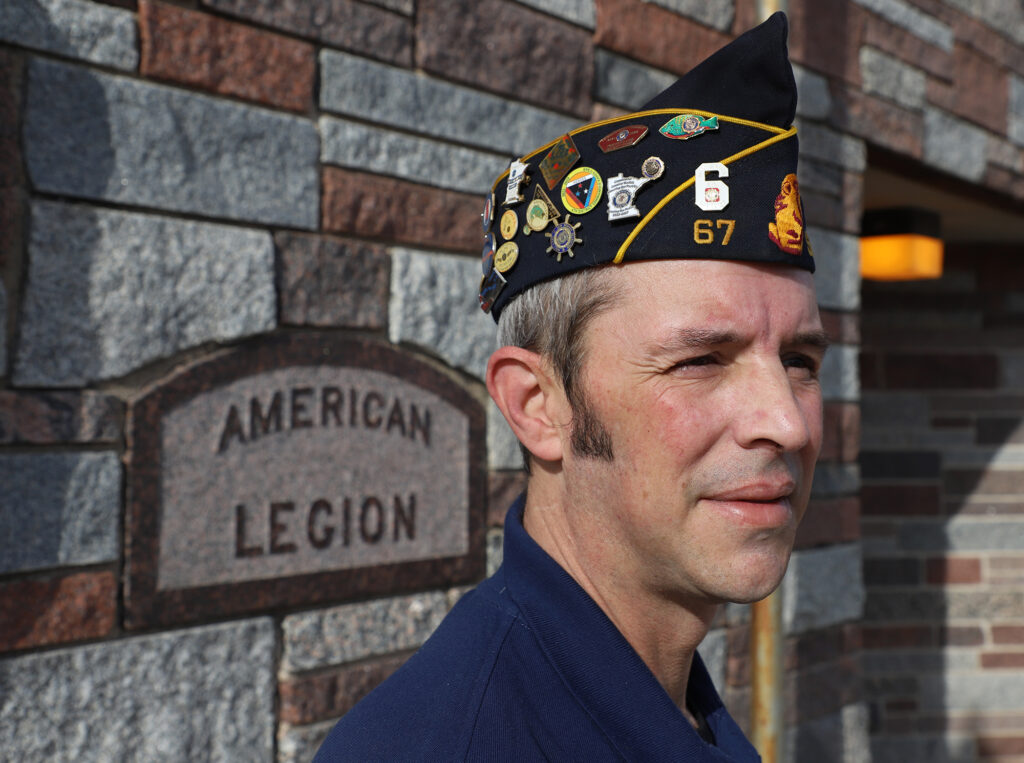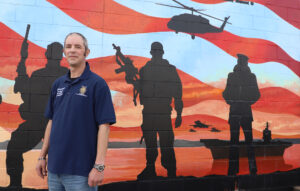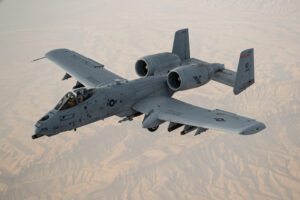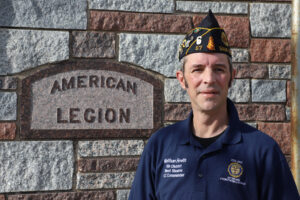
By Tim Engstrom
SAUK CENTRE — The story of Air Force and Army veteran Nathan Smith fits the definition of serendipity: “The occurrence and development of events by chance in a happy or beneficial way.”
Smith, 46, is the adjutant of Sauk Centre Post 67 and commander of the American Legion West Stearns County Council. The former homeless veteran lives in a house with his wife, and his coming to Minnesota was by chance. Beforehand, he seemed to live everywhere but Minnesota.
Now he doesn’t want to live anywhere else. He loves Sauk Centre, his wife and the camaraderie he finds among the veterans of The American Legion.
Smith graduated from high school in Limestone, Maine, in 1994. His father, Keith Smith, was stationed at Loring Air Force Base, which was closed that same year.
“We were one of the last families there,” Nathan Smith said.

The oldest of four children, he grew up in an Air Force family. He was born at Holloman AFB in New Mexico, and was raised at Seymour Johnson AFB in North Carolina, Minot AFB in North Dakota and RAF Alconbury in England.
He entered the Air Force on Aug. 9, and, of course, went to basic at Lackland AFB outside San Antonio, Texas. Then it was off to tech school at Sheppard AFB in Wichita Falls, Texas, where he became a crew chief for the A-10 Thunderbolt II, better known as the A-10 Warthog, a close-support attack aircraft.
The A-10 served with distinction in the Persian Gulf War and had roles in Grenada, the Balkans, Afghanistan, Iraq and, more recently, against ISIS. In service since 1976, with many upgrades since, it can fly with a lot of damage, fire 3,900 rounds a minute and deploy missiles and bombs. Heavy armor, firewalls, extinguishers, redundant systems and enemy-spotting avionics have made it famous — or infamous, if you are the enemy — for being difficult to shoot down.
The Air Force sent Smith to Osan Air Base in South Korea, where his A-10s patrolled the DMZ loaded with bombs and rockets most of the time. He made sure the pilot got in the plane, and when the aircraft returned, he recovered all the items and made repairs. There were usually two flights a day.
Mornings began with a pre-flight inspection. At midday was a through-flight inspection, and at the end of the day was the post-flight inspection. These involved taking oil samples, filling fuel tanks, checking fluids, among other things, including parking and hauling out the aircraft.
His next duty station was Pope AFB in North Carolina, where he was crew chief for A-10s, and he deployed overseas to Kuwait and Iraq, including enforcement of the Iraq No Fly Zone and the 1998 bombing campaign that was Operation Desert Fox.
During his Pope years, the Air Force also sent the senior airman to temporary duties at Nellis AFB in Nevada and Davis-Monthan AFB in Arizona.
After four years, Smith got out and moved to Steamboat Springs, Colo. He had skied a lot as a kid in Maine and wanted to live the life.
He worked for a ski resort in central reservations. He started as an agent and became a team leader. After 2 1/2 years, he moved back with his parents, who were in Minot at this point, because he wanted to break into television.

He started to work for the NBC station KMOT as a reporter, cameraman and editor. He decided to go to college at Full Sail University in Winter Park, Fla., for film and television.
He did well, but Smith never completed his degree because he began getting professional jobs. Most notably, he did freelance work for Outdoor Life Network’s new Resort Sports Network.
In 2004, the country was in two wars, and there was consideration for reinstating the draft. Smith returned to Minot and decided he would re-enter the military. However, the Air Force doesn’t let its veterans re-enlist.
“I chose the Army, but I lost rank. I now was an E-2. I went from blue to green,” Smith said.
He went through a condensed four-week basic training called Warrior Transition Course at Fort Knox, Ky. Then it was off to Fort Sill, Okla., to get artillery training. His military occupational specialty was 13M, a MLRS crewmember. MLRS stands for “multiple launch rocket system.”
“I chose that MOS because I would get to drive to work, not walk,” Smith said.
The Army sent him to the DMZ in Korea. He was stationed at Camp Casey. Often, in the mountainous terrain, his unit would load the rockets, bring the launch vehicle in hiding until called to launch, then go to the firing point and program the coordinates of the target.
Then they would either fire on command or fire when ready.
On American Independence Day 2006, North Korea tested its first nuke-carrying-capable missile. In fact, the country did two rounds of missile tests on two types of missiles.
“That put us all on high alert,” Smith said.
They were on high security, too, which included special battle drills, and this lasted the rest of the year. Smith exited the Army in 2007.
He drifted and ended up homeless in Austin, Texas.
How? He said he had no plan, no money saved, no job lined up.
In 2010, a fellow veteran took him to the Austin VA, where they put Smith on a non-service-connected pension of $1,000 a month while they worked on his claim. He bounced from hotel to hotel, while fighting for this disability claim that never seemed to come through.
Finally, in 2014, he decided to switch scenery and move to Portland, Ore. He was still homeless. He lived in shelters and in the woods.
Smith had a close buddy die during his deployment to Kuwait in Operation Desert Fox. An A-10 aircraft engine fell on his head. Smith felt he should have been the one who died, and, at this point in this life, he didn’t realize he had untreated post-traumatic stress disorder.
“I didn’t know anything about it,” he said. “I thought it was just part of life.”
Finally, the VA diagnosed him as 100 percent service-connected.

In 2016, he bought a car and began travelling around. He ended up at the St. Cloud VA, then transferred to the VA in Hot Springs, S.D., for in-patient PTSD treatment. He completed a 10-week program.
Homelessness has a sense of freedom to it, Smith said, but it’s a daily struggle, too.
“I was fortunate to be getting any compensation,” he said. “It can be difficult for people to come up with the first and last month’s rent, plus a deposit.”
Some folks like that lifestyle, he said, and eventually, it’s all they know.
One day, he decided he was done with it.
He got a ride with his ex-girlfriend to Minnesota from South Dakota. She had previously lived in the Interstate 94 town of Sauk Centre.
Once there, Smith had no money, no car, and he went to Post 67. He started talking to a guy while having a smoke. He and his family turned out to be Christians, and they ordered him a meal — Post 67’s chicken wings and a beer. They also put him up in the Gopher Prairie Inn for a week and paid his cellphone bill.
“Two days later, I met my future wife, and I never left,” Smith said.
Now with online access, he visited a dating website to meet Sauk Centre women and connected with Diane Doubrava. It turns out her family is a big supporter of veterans, and her uncle signed Smith up to be a Legionnaire. The post put him on the housing committee the first week. Her family regularly camps at Legionville’s annual Camporee.
“The Legion gives people a sense of purpose,” he said. “I’m always trying to do stuff for veterans any chance I get.”
That includes organizing a fundraiser to help Legion posts in Kentucky hit hard by tornadoes. He credits his wife for helping him make smart decisions.
Diane and Nathan married June 8, 2018. Thanks to a VA loan, the Smiths purchased a split-level home a little over a year ago. Before, they had lived in an apartment above a garage. She is the director of nursing at Cedar Cove Assisted Living, and he is 100 percent connected, so he doesn’t work. However, he is attending Penn State online, majoring in political science.
As a former homeless veteran, what does he think can be done to help homeless veterans?
“There’s a lot of veterans out there who do not know about veterans programs, and when they do, people fall through the cracks after getting sick and tired of waiting,” Smith said.
He said whatever can be done to reduce waiting times for HUD-VASH housing would be good. Many homeless veterans in shelters do not know there are resources just for them and end up in the civilian systems. Those general shelters need to help them get to veteran shelters.
He said there needs to be greater awareness of the Minnesota Veterans Assistance Fund through the Minnesota American Legion, which can provide temporary assistance to struggling veterans, and of the shelters operated by the Minnesota Assistance Council for Veterans, a nonprofit working to end veteran homelessness in Minnesota.